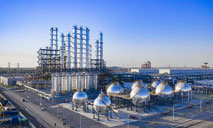China’s summer grain output to hit record high
China reaped another bumper summer harvest, with about 335 million mu (22.3 million hectares) of wheat reaped this year, according to the Ministry of Agriculture and Rural Affairs (MARA). The ministry also estimated that the summer grain yield is expected to increase by 3 kg per mu (one mu is about 667 square meters) and that grain output will hit a record high.

Aerial photo taken on June 6, 2021 shows wheat-reaping harvesters at work in Zhoukou, central China's Henan Province. (Xinhua/Li Jianan)
This success lays a solid foundation for meeting the target of keeping the annual grain output above 650 million tons. To achieve this goal, governments at various levels have given farmers a great deal of policy support to incentivize them.
In Hunan province, a major grain production base in central China, 37 counties have joined a pilot program under which rice growers are provided farm insurance to fend off risks and stabilize income from rice production.
In Fuding, a city in east China’s Fujian province, farmers are granted an allowance of 200 yuan per mu of land as long as they plant more than 30 mu of crops, and will also receive subsidies during the crop sales season.
From 2016 to 2020, China allocated a total of 217 billion yuan to incentivize farmers to grow crops. In 2021, the country implemented the responsibility mechanism under which both the government and the Party take on the role of guaranteeing grain safety.
The country has worked to construct high-standard farmland so as to increase grain output. According to Wu Hongwei, an inspector with the Department of Farmland Enhancement under MARA, by the end of 2020, the country had built 800 million mu of high-standard farmland, which accounted for nearly 40 percent of the country’s total farmland. The yield per mu of land has been raised by 10 percent to 20 percent.
Deng Zhong is a farmer from southwest China’s Chongqing Municipality who upgraded his farmland to high-standard by installing insecticidal lamps, cameras, and sensors to help the crops grow better.
“After re-organizing the farmland, I made sure that each piece of farmland covers no less than 5 mu so that machinery could be used for crop reaping,” said Deng, adding that the rice produced by the high-standard farmland sells for 0.12 yuan per kg more than the rice grown on standard land.
In recent years, the level of agricultural mechanization in China has been continuously improved. The production of three staple crops - wheat, rice and corn - is now mainly carried out with farming machines.
Between 2016 and 2020, the country issued a total of 95.8 billion yuan in funds to subsidize farmers to buy farming machines, boosting the mechanization process of the agricultural industry.
This summer, a total of 16.5 million machines have been used to ensure a smooth summer harvest and disposal of crop straws.
China’s farming sector has also gone high-tech. Last year, the contribution rate of science and technology advances in agriculture topped 60 percent.
“The application of agricultural technologies, including scientific fertilization, water-saving irrigation, and unified prevention and control of crop pests and diseases has significantly improved agricultural production efficiency,” said Wei Qiwen, director of the National Agro-Tech Extension and Service Center.
North China’s Tianjin Municipality plans to encourage the use of organic fertilizers on 1 million mu of rice fields, and after it does so, the total production of rice will increase by 30,000 tons.
“After we started to use organic fertilizers on our rice fields last year, the price of our rice per kg increased by 6 yuan,” said Cui Fenghong, a farmer from Tianjin.
Photos
Related Stories
Copyright © 2021 People's Daily Online. All Rights Reserved.










